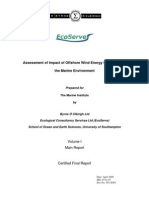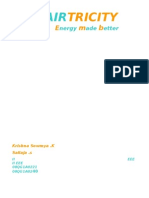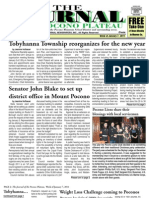Wind Power
Wind Power
Uploaded by
Rachel FabianCopyright:
Available Formats
Wind Power
Wind Power
Uploaded by
Rachel FabianCopyright
Available Formats
Share this document
Did you find this document useful?
Is this content inappropriate?
Copyright:
Available Formats
Wind Power
Wind Power
Uploaded by
Rachel FabianCopyright:
Available Formats
National Audobon: http://www.audubon.org/campaign/windPowerQA.
html Site Summary: Audubon strongly supports properly-sited wind power as a clean alternative energy source that reduces the threat of global warming. Wind power facilities should be planned, sited and operated to minimize negative impacts on bird and wildlife populations. Audubon supports the adoption of federal and state guidelines on the study, siting, operation and mitigation of wind power. Guidelines should provide developers, permitting agencies and conservation groups with the legal, technical and practical steps needed to minimize impacts on birds and other wildlife. 1000 Islands Land Trust (Clayton, NY) http://www.tilandtrust.org/AboutUs/StatementonWindPower.aspx The mission of TILT is to conserve the natural beauty, wildlife habitats and recreational opportunities of the Thousand Islands region; TILT is therefore opposed to the siting of industrial wind turbines within the viewshed of the St. Lawrence River and its tributaries in the Thousand Islands region. Statement on Wind Power Generation in the Adirondack Park http://kirbymtn.blogspot.com/2009/06/statement-on-wind-power-generation-in.html By John Davis, Adirondack land conservationist: We are adamantly opposed to the development of any towers on the Forest Preserve, including wind power turbines. Any proposal for towers on the Forest Preserve would be a violation of Article XIV of the State Constitution, the Forever Wild clause. We are also concerned with visual impacts of projects proposed on private lands that can be seen from Forest Preserve lands. Although there are locations throughout the North Country where wind is sufficient to accommodate wind power generation, commercial wind facilities are also inappropriate on private lands within the Adirondack Park. Given the land use policies in the Adirondack Park Agency Act, the Adirondack Park Agencys Policy on Agency Review of Proposals for New Telecommunications Towers and other Tall Structures in the Adirondack Park (APAs Towers Policy), Adirondack Park Agency Rules and Regulations, the Adirondack Park State Land Master Plan, the purposes for which the Park was created, and the Parks critical importance to regional wildlife habitat integrity and connectivity, commercial wind tower facilities should not be permitted within the Blue Line. Alliance to Protect Prince Edward County(Ontario) http://appec.wordpress.com/2009/04/04/position-statement-industrial-wind-turbine-development/ The Alliance to Protect Prince Edward County believes that any installation of industrial-scale windturbine complexes in Prince Edward County will be detrimental to its unique historical, agricultural, cultural and rural character. There are no locations within the County or in the near shore waters, where a wind turbine complex would not severely impact the health, environment, creative and rural economies and quality of life of its citizens. APPEC is therefore opposed to the development of industrial wind projects in Prince Edward County. Lake Eerie Committee http://www.glfc.org/lakecom/lec/LEC_docs/position_statements/offshore_wind_power.doc. All offshore windpower projects include; A demonstration of clear and substantial public benefit, including, but not limited to, environmental benefit. Long-term ecological monitoring should occur both pre-construction and post-construction.
Adaptive mitigation measures that would reflect monitoring results. If negative impacts are identified, projects should be re-sited or adjusted to minimize impacts to Lake Erie fisheries and fish habitat. Adaptive management should be implemented for future proposals as best-management practices are developed. Areas identified as biologically or physically sensitive or areas of archaeological, recreational and commercial values should be protected from offshore windpower development. American Littoral Society (Highlands, NJ) http://www.littoralsociety.org/userfiles/doccenter/ALSPositionOnOffShoreWind0907.doc.pdf All the while, this dash toward wind has diverted attention from the difficult and politically distasteful changes we must make to the houses we live in, the cars we drive, the food we eat, and just about every other aspect of the way we live, challenges which are truly at the root of addressing global climate change. This is a dangerous diversion that not only puts already stressed coastal resources and public money at risk, but also risks postponing the more difficult actions we need to take to reverse global warming past the point of no return.
You might also like
- SWOT Matrix Millat TractorsDocument1 pageSWOT Matrix Millat Tractorsshayan100% (1)
- I Am Not Sidney Poitier QuizDocument2 pagesI Am Not Sidney Poitier QuizRachel Fabian0% (1)
- Group 2 - A Case Study of Penang Island City Council (MBPP)Document11 pagesGroup 2 - A Case Study of Penang Island City Council (MBPP)noraaesya 82100% (1)
- Environmental Laws in The PhilippinesDocument7 pagesEnvironmental Laws in The PhilippinesCrisha Joy Delos SantosNo ratings yet
- SismanDocument9 pagesSismanSulaiman AbdulazeezNo ratings yet
- A Proposed Eco Park ResortDocument22 pagesA Proposed Eco Park ResortMae Ann Pacatang IsitNo ratings yet
- For An Example You Hcasestudyave StudiedDocument23 pagesFor An Example You Hcasestudyave Studiednityam bajajNo ratings yet
- Offshore-Wind-Energy-Strategies-Report 57Document1 pageOffshore-Wind-Energy-Strategies-Report 57김대환No ratings yet
- Mass Audubon Wind Power 2Document5 pagesMass Audubon Wind Power 2ztowerNo ratings yet
- Case Study - Austral Launch Services v1Document4 pagesCase Study - Austral Launch Services v1Maulana PSamilNo ratings yet
- Green Gravel: Priorities For Aggregate Reform in OntarioDocument4 pagesGreen Gravel: Priorities For Aggregate Reform in OntarioSTOP THE QUARRYNo ratings yet
- Assesmentof Impactof Offshore Wind Energy StructuresDocument93 pagesAssesmentof Impactof Offshore Wind Energy StructuresPangeran Haridez Abdullah FauzanNo ratings yet
- Philippine Environmental Regulations: Prepared By: Karla Charmagne B. Saliva, Ece, EctDocument50 pagesPhilippine Environmental Regulations: Prepared By: Karla Charmagne B. Saliva, Ece, EctKarla Charmagne BeatoNo ratings yet
- Tidal Energy:: - Worldwide Distribution - Efficient Technology - Multiple BenefitsDocument31 pagesTidal Energy:: - Worldwide Distribution - Efficient Technology - Multiple BenefitsRashi JainNo ratings yet
- West Michigan Wind Assessment April 2013Document17 pagesWest Michigan Wind Assessment April 2013Jhonatan HurtadoNo ratings yet
- Case StudyDocument7 pagesCase Studyroderick biazonNo ratings yet
- New Project ProposalDocument22 pagesNew Project ProposalMustapha RasheedNo ratings yet
- 03 ScreeningDocument15 pages03 ScreeningrieNo ratings yet
- PP 2146 - Environmentally Critical AreasDocument1 pagePP 2146 - Environmentally Critical AreasMichelle Mae MabanoNo ratings yet
- No Economically Recoverable Oil in The Coastal Plain, While at A Price of $24 ADocument5 pagesNo Economically Recoverable Oil in The Coastal Plain, While at A Price of $24 AreasonorgNo ratings yet
- Site Visit Report SampleDocument29 pagesSite Visit Report SamplevishnuprasadNo ratings yet
- Final PresentationDocument28 pagesFinal Presentationapi-306590034No ratings yet
- Feasibility ConsiderationsDocument3 pagesFeasibility ConsiderationsEngineering discoveryNo ratings yet
- Public Comment From NYS Assembly Minority Leader Brian Kolb On RdSGEIS, Oct 24, 2011Document2 pagesPublic Comment From NYS Assembly Minority Leader Brian Kolb On RdSGEIS, Oct 24, 2011Jon CampbellNo ratings yet
- Cayman Islands National Biodiversity Action Plan 2009 2.M.6 Marine Habitats Artificial InstallationsDocument4 pagesCayman Islands National Biodiversity Action Plan 2009 2.M.6 Marine Habitats Artificial Installationssnaip1370No ratings yet
- Fostering a blue economy: Offshore renewable energyFrom EverandFostering a blue economy: Offshore renewable energyRating: 1 out of 5 stars1/5 (1)
- Coastal Lakeside Community PlanningDocument24 pagesCoastal Lakeside Community PlanningHuelson Anadi100% (3)
- An Offshore Wind TurbineDocument4 pagesAn Offshore Wind TurbinePVD RemixNo ratings yet
- 1 s2.0 S0308597X12001728 MainDocument7 pages1 s2.0 S0308597X12001728 Mainzainab MOHAMMEDNo ratings yet
- Environmental Laws Atty. de PedroDocument86 pagesEnvironmental Laws Atty. de PedroAngel JairaNo ratings yet
- Green Infrastructure For The Coast: A Primer For Local Decision MakingDocument52 pagesGreen Infrastructure For The Coast: A Primer For Local Decision MakingelinzolaNo ratings yet
- Wind AssesmentDocument16 pagesWind AssesmentMuluken TemesgenNo ratings yet
- Eco Sensitive ZonesDocument28 pagesEco Sensitive ZonesAnima JainNo ratings yet
- Wetlands RestorationDocument2 pagesWetlands RestorationAhmed RashidNo ratings yet
- Env Impact AssessmentDocument81 pagesEnv Impact AssessmentLisa CullenNo ratings yet
- Fish Passage Mitigation of Impacts From Hydroelectric Power Projects in The United StatesDocument14 pagesFish Passage Mitigation of Impacts From Hydroelectric Power Projects in The United Statesandriwarsa115281No ratings yet
- PD No. 2146Document7 pagesPD No. 2146rex tanongNo ratings yet
- EIA ProjectDocument14 pagesEIA Project21bal018No ratings yet
- Lecture 17. Environmental Impact AssessmentDocument34 pagesLecture 17. Environmental Impact AssessmentDutchsMoin Mohammad100% (1)
- Envoiremental & Pollution ControlDocument0 pagesEnvoiremental & Pollution ControlSHIVAJI CHOUDHURYNo ratings yet
- ethiopia-belchit_eia_final-zereuDocument170 pagesethiopia-belchit_eia_final-zereuhaileNo ratings yet
- Finance - United UtilitiesDocument4 pagesFinance - United UtilitiesRohit DhoundiyalNo ratings yet
- West Garty Wind Farm CC DocumentsDocument10 pagesWest Garty Wind Farm CC DocumentsDavid MasonNo ratings yet
- Multiple Objectives, One Marine Planning ProcessDocument2 pagesMultiple Objectives, One Marine Planning ProcessRia PatelNo ratings yet
- Tricity: Nergy Ade EtterDocument11 pagesTricity: Nergy Ade Ettersowmyak21No ratings yet
- National Offshore Wind Strategy PDFDocument52 pagesNational Offshore Wind Strategy PDFBalan PalaniappanNo ratings yet
- Eia Assignment No 5Document10 pagesEia Assignment No 5Swati GuptaNo ratings yet
- The Environmental ImpactDocument13 pagesThe Environmental ImpactISRAEL VENIEGASNo ratings yet
- A E: E D P R: Ppendix Nvironmental Iscussion of Olicies and EgulationsDocument2 pagesA E: E D P R: Ppendix Nvironmental Iscussion of Olicies and EgulationsPlanning DocsNo ratings yet
- Estimation of Water Production CostDocument7 pagesEstimation of Water Production Costsurishetty10No ratings yet
- Natural EnglandDocument6 pagesNatural EnglandbenconnolleyNo ratings yet
- Coastal Zone MBA DMDocument4 pagesCoastal Zone MBA DMsaksham111No ratings yet
- 8 LAND GOVERNANCEDocument84 pages8 LAND GOVERNANCENathan IplierNo ratings yet
- How To Request An Environmental AssessmentDocument3 pagesHow To Request An Environmental AssessmentSTOP THE QUARRYNo ratings yet
- Wind Energy Siting Plan - Working Document Version 1 DraftDocument48 pagesWind Energy Siting Plan - Working Document Version 1 DraftfilmtruthNo ratings yet
- LDO Response 2013 PaullPCDocument4 pagesLDO Response 2013 PaullPCRayDuffNo ratings yet
- Land-Based Salmon Farming Concerns and Responses: ScaleDocument4 pagesLand-Based Salmon Farming Concerns and Responses: ScaleRobertas KupstasNo ratings yet
- A Multipurpose, Artificial Reef at Mount Maunganui Beach, New Zealandrpose, Artificial Reef at Mount Maunganui Beach, New ZealandDocument13 pagesA Multipurpose, Artificial Reef at Mount Maunganui Beach, New Zealandrpose, Artificial Reef at Mount Maunganui Beach, New ZealandIsabel Duarte de AlmeidaNo ratings yet
- Hurricanes and The Oil and Natural Gas Industry Preparations PDFDocument5 pagesHurricanes and The Oil and Natural Gas Industry Preparations PDFFabian MederosNo ratings yet
- Electric 15Document19 pagesElectric 15engrfahadkhanNo ratings yet
- Assignment Wind Farm CaseDocument5 pagesAssignment Wind Farm CaseLary-an CawasNo ratings yet
- Design ProjectDocument83 pagesDesign ProjectArun KurheNo ratings yet
- Preparing Outer Islands for Sustainable Energy Development: Maldives’ Experience in Deploying Advanced Hybrid Renewable Energy SystemsFrom EverandPreparing Outer Islands for Sustainable Energy Development: Maldives’ Experience in Deploying Advanced Hybrid Renewable Energy SystemsNo ratings yet
- Anger Arises Among Black PeopleDocument1 pageAnger Arises Among Black PeopleRachel FabianNo ratings yet
- Inception Narrative AnalysisDocument2 pagesInception Narrative AnalysisRachel Fabian100% (2)
- Do Not Discuss Cold WeatherDocument1 pageDo Not Discuss Cold WeatherRachel FabianNo ratings yet
- German Midterm ExaminationDocument4 pagesGerman Midterm ExaminationRachel FabianNo ratings yet
- Lecture Review 70SSBWK1: Ideology /reality & Media RepresentationDocument1 pageLecture Review 70SSBWK1: Ideology /reality & Media RepresentationRachel FabianNo ratings yet
- Death, Myth and RitualDocument18 pagesDeath, Myth and RitualRachel FabianNo ratings yet
- Sunita Sharma: Application Form (For Resident Applicants) Asba Application FormDocument1 pageSunita Sharma: Application Form (For Resident Applicants) Asba Application Formitsyour vinESNo ratings yet
- Painted Nails - A Nonsensical Short StoryDocument2 pagesPainted Nails - A Nonsensical Short StoryGina SykesNo ratings yet
- Tobyhanna Township Reorganizes For The New Year: JournalDocument12 pagesTobyhanna Township Reorganizes For The New Year: JournalCoolerAdsNo ratings yet
- Updated Rizal Lecture Notes 2021Document32 pagesUpdated Rizal Lecture Notes 2021Admin 2100% (1)
- Database DokterDocument34 pagesDatabase DokterMedRep CITO KudusNo ratings yet
- DFID Inclusive Elections Proposal FINAL VERSIONDocument22 pagesDFID Inclusive Elections Proposal FINAL VERSIONLexico International100% (1)
- Madeness of KinglearDocument11 pagesMadeness of KinglearRai Waheed RabbaniNo ratings yet
- Artikel 4Document12 pagesArtikel 4Vika GhinaNo ratings yet
- All Artist Rate ListDocument19 pagesAll Artist Rate ListNitin MahawarNo ratings yet
- 1 Introduction To Pricing StrategyDocument9 pages1 Introduction To Pricing Strategymayank_chowdharyNo ratings yet
- Auditing & Assurance - Summary Book (Ch. 1 To Ch. 13)Document274 pagesAuditing & Assurance - Summary Book (Ch. 1 To Ch. 13)ronex45326No ratings yet
- Model LPS: CeltronDocument3 pagesModel LPS: CeltronAhmed AlabsiNo ratings yet
- NYS Assembly Yellow BookDocument323 pagesNYS Assembly Yellow BookCeleste KatzNo ratings yet
- New Year's Eve 2018 - Google Doodles Wiki - FandomDocument4 pagesNew Year's Eve 2018 - Google Doodles Wiki - FandomchefchadsmithNo ratings yet
- Online Guest Room Booking SystemDocument19 pagesOnline Guest Room Booking SystemPankajNo ratings yet
- Dahua Name ConventionDocument61 pagesDahua Name ConventionMihai RaduNo ratings yet
- A New Look at Molten Salt Reactors: By: Louis Qualls, PH.DDocument6 pagesA New Look at Molten Salt Reactors: By: Louis Qualls, PH.DGoran OsmakNo ratings yet
- Miguel Et Al-2004-Strategic Management JournalDocument9 pagesMiguel Et Al-2004-Strategic Management JournalWasiq Ullah HamdardNo ratings yet
- Thinking of Building?: Stony Stratford Design GuideDocument12 pagesThinking of Building?: Stony Stratford Design GuidedavpaffNo ratings yet
- Slope Construction Updated Rev November 2020Document10 pagesSlope Construction Updated Rev November 2020Faiz BukhariNo ratings yet
- Stress ManagementDocument3 pagesStress ManagementadadidloadNo ratings yet
- Obstetric Violence - A Latin American Legal Response To Mistreatment During ChildbirthDocument4 pagesObstetric Violence - A Latin American Legal Response To Mistreatment During ChildbirthAnaNo ratings yet
- The Modern Supernatural and The Beginnings of Cinema 1st Edition Murray Leeder (Auth.) Download PDFDocument54 pagesThe Modern Supernatural and The Beginnings of Cinema 1st Edition Murray Leeder (Auth.) Download PDFbaratoepanya100% (2)
- Implications of Human Resource ManagementDocument14 pagesImplications of Human Resource ManagementRokibul HasanNo ratings yet
- Philippine HistoryDocument31 pagesPhilippine HistoryAnaliza Mg OriasNo ratings yet
- 1 - FINAL - A Ballad of Proximity - A Neoformalist Analysis of Chungking Express-CompressedDocument58 pages1 - FINAL - A Ballad of Proximity - A Neoformalist Analysis of Chungking Express-CompressedzhangyijiajenNo ratings yet
- Grade 7 Consolidation - Lesson 25 26Document21 pagesGrade 7 Consolidation - Lesson 25 26Cecilia DavalosNo ratings yet
- Bahasa Inggeris K3 SET 2 MPP3 2022Document8 pagesBahasa Inggeris K3 SET 2 MPP3 2022FhatinNo ratings yet
































































































